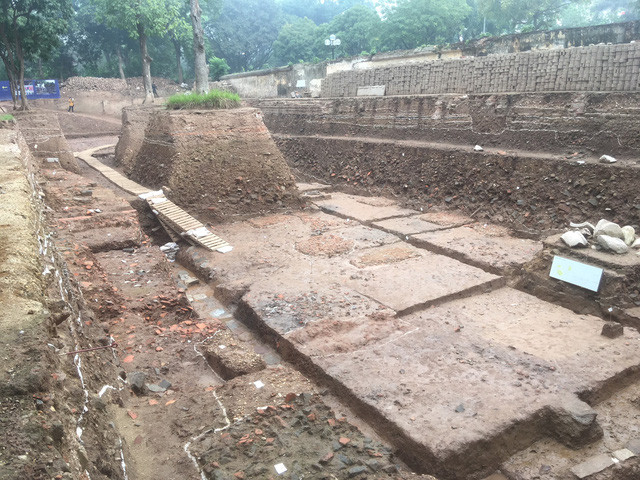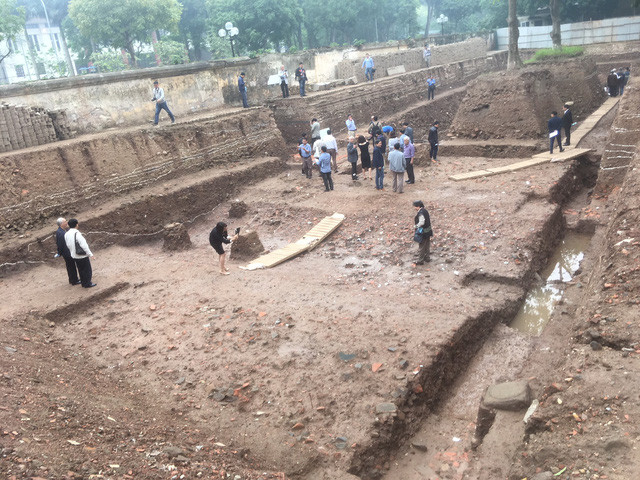Discovering vestiges of the palace during the Le So period in Thang Long Citadel
On the morning of April 17, the Center for Conservation of Thang Long - Hanoi Royal Citadel and Vietnam Institute of Archeology held a scientific workshop to briefly report the results of the excavation of Kinh Thien Dien main area. 2017 at 9 Hoang Dieu.
Traces of thousands of years of underground palace
Accordingly, in 2017, these two units conducted excavation and exploration in the eastern area of Kinh Thien electricity base (adjacent to Nguyen Tri Phuong street) with a total area of nearly 1,000m 2 .
The excavation pit consists of 16 layers of excavation, the average layer of 20cm thick, the development is complicated because it has undergone a history process that has been destroyed due to the intrusion of the later stage into the previous cultural layers.
According to Associate Professor Dr. Trung Trung Tin - Chairman of Vietnam Archeology Society, the excavation has revealed a nearly 4.5m-thick cultural layer with cultural classes dating back to the time of Dai La, Dinh and Tien Le. , Ly, Tran, Le So, Le Trung Hung, Nguyen to modern times. The excavation has revealed three vestiges of the Ly-Tran architecture, some architectural vestiges of the Le So, Le Trung Hung and Nguyen dynasties. The basic characteristics of materials, types of remnants are found including: column foundations, wall foundations, architectural foundations, background bundles .


The whole pit excavated in the east of Kinh Thien - Thang Long Citadel.(Photo: Tung Long).
Relics found in these cultural layers belong to many different types such as earthenware, pottery, woodwork, metal furniture, including a large number of bricks and tiles. The most typical of these is brick and tile decoration material of the roof of the palace with gold enamel (royal glass) and the blue glaze (lychee) of the Le So period (15th century to the beginning of the 17th century).
Associate Professor Tong Trung Tin said that these relics allow for a clearer picture of the 'dragon tile', the dragon head on the roof, the dragon tail at the corner of the roof . the palace roof in the main area of Kinh Thien Hoang's temple Le So. In addition, a significant finding was that the excavation area found quite a lot of ceramics in the Mac period (around the 16th century). The relics of the Mac era show that the Mac dynasty acquired the whole time of Le So, only minor repairs.
It is worth noting that the architectural vestiges of the Tran period found that this strip of lemon flower background has a very large size, the rest is 1.15m long. The construction materials of lemon flower road are flat, flat tiles . arranged very elaborately. This feature shows that this is a vestige of early Tran dynasty architecture (13th century) and this is an architectural period of the Tran Dynasty occupying an important position in Thang Long palace during the Tran dynasty. This is also the largest strip of lemon flowers (except for the dome-shaped lemon flower in the Tran Dynasty at 18 Hoang Dieu) in most strips of lemon flower in other locations of Thang Long Citadel and other relics of Dai Viet. Tran dynasty.

Associate Professor Tong Trung Tin and Prof. Phan Huy Le and Director of Thang Long Royal Heritage Center visit the excavation pit.(Photo: Tung Long).
The architecture of Le Trung Hung's period found that the walls of the brick walls were very solid. It is said that this is the vestige of the gate in the prohibition of Thang Long citadel in Le Trung Hung period. This cultural layer also has traces of stone foundations, which are being guessed as a kind of palace pond. This mark is being explored by nature and chronology.
There are enough archaeological data to build Kinh Thien electric space
GS. Dr. Nguyen Quang Ngoc - Vice Chairman of Vietnam Association of Historical Sciences said that the vestiges of architecture and the new relic system were discovered very new compared to the past. The new can be confusing for researchers but very precious. These findings continue to reflect complex developments in the architectural traces of Kinh Thien's power through historical dynasties. And this must necessarily have an overall map, connecting excavation sites so far to be able to visualize the whole and find the central axis of Kinh Thien electricity.
Many scientists also suggest that more research on the lake has just been found in the recent excavation pit to see the connection of this vestige with Dai La, Ly, and Tran . Especially, it should be clarified. Mac elements through the cultural floors and artifacts found during excavation. More importantly, it is advisable to develop an extensive excavation plan and speed up excavation to return the space to Kinh Thien.

Tong Trung Tin, PhD, introduced the artifacts found in the excavation pit.(Photo: Tung Long).
Prof. Phan Huy Le - Chairman of Vietnam Association of Historical Science stated that the results of excavation in the eastern area of Kinh Thien electricity platform have brought about new results. On that basis, many new issues are raised for researchers.
'I see this excavation hole has the deepest depth ever and has the architectural vestiges throughout the Dai La period until Nguyen. Although the Dai La vestige in the excavation hole this time was quite small, it partly proved that the scope of Đại La spread from Doan Mon to Thien. Time Ly, Tran, Le . we also found architectural vestiges, especially the strip of lemon flower in the Tran period 1.15m long. So it is possible to guess here a huge architecture existed.
In particular, architectural materials of this time of Le found extremely rich. These materials have the scale of the palace roof during the Le So period. Having enough materials to study in that direction ' , Prof. Phan Huy Le emphasized.
Prof. Phan Huy Le also said that through the comments of scientists, researchers and archaeologists need to consider 3 issues. Firstly, archaeological excavation plan that City People's Committee. Hanoi is approved every year to excavate 1000m2. This number is reasonable, there is no need to expand the area and accelerate. The important thing is that excavation needs a specific and scientific plan.
'I suggest that the next time focus on excavating all the time from Doan Mon to Kinh Thien and after Kinh Thien in a certain limit. Somehow, we have enough archaeological data to build Kinh Thien electric space. I emphasize that the restoration of Kinh Thien electric space and the restoration of Kinh Thien electricity is in fact very difficult. Particularly for roof construction and some architectures, it can be done , 'Professor Le said.

Some Le dynasty relics found under the glass of Kinh Thien.(Photo: Tung Long).
According to Prof. Phan Huy Le, excavation needs to be associated with research, not just excavation. It is time to connect excavation points to visualize the architecture over time. On that basis, organize a scientific workshop to discuss all the issues raised. In addition, these are excavations for conservation, not for clearance. Therefore, after each excavation it is necessary to propose a specific conservation plan. What preserves in a short time, needs soon for people to visit; What needs to be preserved for a long time must also be planned. In addition, it is necessary to document everything at the highest level.
- Large architecture of the Ly Dynasty revealed in Thang Long Citadel
- Revealing huge waterways under Thang Long Citadel
- Relic area of the Imperial Citadel of Thang Long - Hanoi
- Discovering many vestiges and ancient relics in Ho Citadel
- The site of the archaeological site of Hoang Thanh
- Revealing a complex of ancient architectural foundations in Thang Long Citadel
- Discovering many valuable archeological artifacts at the ancient Vietnamese 'city'
- BaKu ancient citadel, Shirvanshah Palace and Maiden tower
- Found the palace in the tomb of Qin Shihuang
- Discovering vestiges of caverns in Tuyen Quang
- Discovering extremely rare footprints of ancient people 14,000 years ago
- Discover the palace of Kublai Khan under the Forbidden City
 Discovered an ancient centipede fossil 99 million years old
Discovered an ancient centipede fossil 99 million years old Discovered bat-like dinosaurs in China
Discovered bat-like dinosaurs in China Discovered a 200-year-old bronze cannon of the coast
Discovered a 200-year-old bronze cannon of the coast Discover 305 million-year-old spider fossils
Discover 305 million-year-old spider fossils